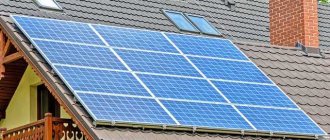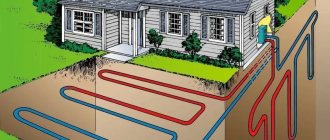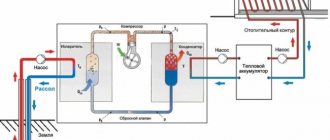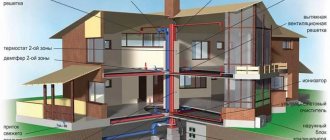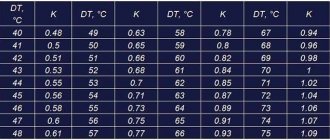The phrase “geothermal energy” for most people evokes associations with Iceland, geysers and volcanoes; others will remember the industrially developed deposits of thermal waters in Kamchatka, Dagestan, and the Stavropol Territory. However, geothermal energy is not only industrial scale, but also private sector geothermal heating. For example, in the Scandinavian countries about 1.5 million homes are heated using heat pumps, and similar projects are being implemented in Russia. We will understand how underground heating technology works, in what forms it is implemented, and how effective it is.
Installation of geothermal equipment Source b-cdn.net
How it works
It is a well-known fact that the soil temperature at a depth of about 1.5 m or more is constant throughout the year. Its value lies in the range of plus 5-7 ° C, and the temperature gradually increases with increasing depth. Thanks to this phenomenon, people store food and vegetables from their gardens in basements.
It turns out that the temperature there is always positive and it would be a sin not to use this heat from the ground to heat your home.
It is absolutely pointless to move such weak heat as +7 °C into rooms. The problem is not like this: we need energy, not temperature. And a regular air conditioner can help with this, only turned upside down. After all, what is he doing? In summer it takes energy from inside the building and moves it outside, and in winter it moves it in the opposite direction. This occurs due to heat exchange processes inside the refrigeration machine (Carnot cycle).
In short and in simple words, a liquid – coolant – circulates inside the air conditioner between two heat exchangers. In the first, it evaporates, taking heat from the air in the room, and in the second, it condenses, releasing it into the environment. The transition of the refrigerant from one state of aggregation to another is facilitated by 2 main units - the compressor and the expansion valve.
In the same way, the thermal energy of the earth is released. A coolant heated to a temperature of +7 °C moves along a contour of pipes placed deep in the soil. In the first heat exchanger, it meets the working fluid - freon, causing it to evaporate. In the second, freon condenses, transferring the resulting thermal energy to the heating system.
As a result of this movement, the earth cools by 2-3 °C, but the house warms up by 20-40 °C
You should not pay attention to the temperature discrepancy, because 10 times more liquid circulates in the earth circuit than in the heating circuit. Energy consumption is negligible; electricity is consumed to operate the compressor, pump and automation
In general, the ratio of energy consumption to energy extracted from the ground is approximately 1: 5–1: 7.
System installation
Geothermal heating of a country house at the stage of arrangement requires substantial financial investments. The high final cost of the system is largely due to the large volume of earthworks associated with the installation of the heating circuit.
Over time, the financial costs pay off, since the thermal energy used during the heating season is extracted from the depths of the earth with minimal energy consumption.
Installation of a horizontal heat exchanger for a geothermal heating system
- the main part should be located underground or at the bottom of a reservoir;
- In the house itself, only fairly compact equipment is installed and a radiator or underfloor heating circuit is laid. Equipment located inside the house allows you to regulate the heating level of the coolant.
What does geothermal equipment look like in a home?
When designing heating using ground heat, it is necessary to decide on the installation option of the working circuit and the type of collector.
There are two types of collectors
:
- Vertical - sinks into the ground several tens of meters. To do this, you need to drill a number of wells at a short distance from the house. The circuit is immersed into the wells (the most reliable option is cross-linked polyethylene pipes).
- Disadvantages: Large financial costs for drilling several wells in the ground with a depth of 50 meters.
Advantages: The underground location of the pipes at a depth where the soil temperature is stable ensures high efficiency of the system. In addition, the vertical collector occupies a small area of land.
- Horizontal. The use of such a collector is allowed in regions with warm and temperate climates, since the depth of soil freezing should not exceed 1.5 meters.
- Disadvantages: The need to use a large area of the site (the main disadvantage). After laying the circuit, this piece of land cannot be used for a garden or vegetable garden, since the system works by releasing cold when transporting the refrigerant, which will cause the plant roots to freeze.
Advantages: Cheaper earthworks, which you can even do yourself.
Horizontal and vertical collector type
Geothermal energy can be extracted by laying a horizontal geothermal circuit at the bottom of a frost-free reservoir. However, this is difficult to implement in practice: the reservoir may be located outside of private territory and then the installation of the heat exchanger will need to be approved. The distance from the heated object to the reservoir should be no more than 100 meters.
Features and installation procedure
The installation of geothermal heating in a private home should be entrusted to specialists. The main difficulties arise when installing the heat exchanger circuit in the ground. The main stages are the following:
1. Engineers visit the site. At the same time, they find out the features of the area and choose the most effective installation method.
2. Conclusion of an agreement and purchase of equipment.
3. Installation work. Heat exchangers are being installed in the ground. Then the geothermal installation is connected to the heating circuit of the building.
4. Commissioning works. After their completion, a certificate of delivery is signed.
The efficiency of the installation is influenced by the type of heat source. The most effective option is to install the heat exchanger circuit near a thermal source or at the bottom of a reservoir. The company installing the equipment may provide the customer with additional warranties. In accordance with current legislation, this is permitted subject to payment for such services. This will cost the customer an additional fee.
Installation and installation of geothermal heating
The main difficulty regarding the installation of geothermal equipment is associated with the installation of the heat exchanger circuit in the soil-ground. Although you can find a lot of advice on the Internet on how to do this work yourself, practice shows that most of the advice cannot be applied without special specialized education, therefore, all work must be performed by professional installers who are representatives of the manufacturer.
After contacting specialists, geothermal heating systems for private houses using the heat of the earth are installed in the following several stages:
- An engineer will visit your home. During the first visit, soil samples are taken, the features of the area are determined, and a decision is made on the most effective installation of the geothermal system. The efficiency of the installation can also be affected by the source of the intended heat. It is considered more productive to install heat exchangers at the bottom of a reservoir or at the sources of thermal sources.
- Concluding an agreement and purchasing the necessary equipment. Prices may vary significantly depending on the complexity of the installation work and other nuances. But on average, if a high-quality German manufacturer is chosen, the cost of installation will be approximately equal to its price. Turnkey purchase of Vaillant installation for a house of 350 sq. m. will cost approximately 21 thousand $
- Installation work. Heating a private house with underground geothermal heat sources, or rather, its efficiency largely depends on the correct implementation of work at the installation stage. After the water heat exchangers are installed in the ground, a connection is made to the geothermal installation and home heating system.
- Commissioning works. The engineer starts the system and makes fine adjustments to the device. After setup, the Work Completion Certificate is signed. According to current legislation, the company installing the equipment may provide additional warranties subject to payment for these services. Such guarantees will cost an additional $1000.
Operating principle of the heating system
People have always tried to get the heat emanating from the bowels of the earth. Thanks to the advent of geothermal heating, this became possible.
In the center of the earth there is magma, which warms the earth. Due to the presence of the top layer of soil, it does not cool. It was enough to learn how to use such heat to open an alternative source of heat. With its proper use, it will be possible to solve the problem of heat supply of any country houses.
Many people find the operating principle of a geothermal heat pump quite complex. In fact, it is enough to understand the features of heating from the ground. The operation of the system is possible due to the presence of an external circuit. performing the functions of a heat exchanger. It is located in water or underground. Inside this element there is water or any other liquid that absorbs heat. The coolant enters the geothermal pump, which accumulates heat. This equipment distributes the received energy throughout the entire internal circuit.
It is worth noting that such heat pumps correspond to standard sizes, but their performance turns out to be really high.
Types of installations for ground heat extraction
The internal structure of the heat pump, briefly described above, remains unchanged in any case. But the design of the external circuit, which extracts energy from the ground, comes in two types:
- horizontal: a polymer pipe with a certain pitch is laid in a pit of the calculated size and depth of 1.5-2 m;
- vertical: circuit pipes are lowered into deep wells. Their number is also determined by calculation.
It is convenient to dig a pit at the stage of construction of a private house; this is done exactly in the place where the building is planned to be erected. Also, a horizontal contour can be arranged if there is a sufficiently large plot of land near the house. When there is no such area and there is very little space, the earth’s energy is collected by geothermal probes from deep wells. You will have to do several of them in different places.
The ends of the pipes from one or more external circuits are laid underground to the house and enter the basement of the building, where they are connected to the heat pump itself. The coolant flowing in underground coils is usually water or non-freezing liquid, depending on the region of construction.
In terms of the efficiency of obtaining energy from the earth, vertical contours are superior to horizontal ones, since they often pass through aquifers, and this improves the selection of heat. They also hold the lead in terms of installation cost, especially if wells are drilled in difficult conditions.
Calculations
The main parameters that are taken into account in any calculations are:
- temperature (depths from 15-20 m or more warm up from 8 to 100 degrees, depending on the conditions);
- extracted power value (average value - 0.05 kW per 1 m);
- the influence of climate, humidity and contact with groundwater on heat transfer.
What is very interesting is that completely dry rocks emit no more than 25 W per 1 m, and if there is groundwater, this figure rises to 100-110 W. We must not forget that the standard operating time of a heat pump is 1800 hours per year. If you exceed this figure, the system will not become more efficient, but its wear will rapidly increase. What is much worse, excessive exploitation of the thermal resource of the subsoil leads to its cooling and even to the freezing of rocks at the working depth. Following this, the soil may subsidence, sometimes damaging working pipes and above-ground structures.
Construction of a geothermal heating system
Geothermy (the science of the thermal state of the Earth) has made possible the practical use of thermal energy that the earth's crust receives from the hot magma in the center of the planet.
A specially designed heat pump for heating a house is installed on the surface, and a heat exchanger is mounted in the ground or at the bottom of a reservoir. Thermal energy is “pumped out” to the surface and makes it possible to heat the coolant in the heating circuit of a house or non-residential facility.
How does the heating process occur?
Geothermal heating of a private home is a cost-effective option. If you use the earth's energy to heat a house, then for every kilowatt of electricity required to operate the equipment, there is from 4 to 6 kW of useful thermal energy obtained from the bowels of the planet.
In comparison with the operation of an air conditioner, we will see that when operating it, more than 1 kW of electricity is required to produce 1 kW of thermal energy. This is due to the inevitable losses in converting one energy into another, etc.
Heating a residential building using the thermal energy of the earth’s interior is very profitable, but the payback period for the equipment and installation costs will take some time.
Using the heat of the earth to heat a house does not require installing a traditional boiler to heat the coolant.
In this case, the system consists of three components
:
- heating circuit - geothermal source of thermal energy;
- heating circuit inside the house - low-temperature radiator or floor;
- pumping station - a heat pump for pumping thermal energy into a heating circuit from a heating circuit in the soil or under water.
Geothermal heating systems can also be used to heat greenhouses, outbuildings, swimming pool water, garden paths, etc.
Costs and payback prospects
The costs of equipment and its installation during the construction of geothermal heating depend on the power of the unit and the manufacturer.
Everyone chooses a manufacturer based on their own considerations and information about the reputation and reliability of a particular brand. But the power depends on the area of the room to be served.
This figure summarizes the benefits of using a geothermal heating system. It is precisely this ratio of incoming and outgoing energy that allows the system to first quickly pay for itself and then save its owner’s money (+)
If we take power into account, the cost of heat pumps varies in the following ranges:
- for 4-5 kW – 3000-7000 conventional units;
- for 5-10 kW – 4000-8000 conventional units;
- for 10-15 kW – 5000-10000 conventional units.
If we add to this amount the costs that are needed to carry out installation work (20-40%), then we will get an amount that for many will seem absolutely unrealistic.
But all these costs will be recouped in a very reasonable time frame. In the future, you will only have to pay minor expenses for the electricity needed to operate the pump. And it's all!
Due to the insufficient efficiency of geothermal systems for heating residential buildings, they are used as an addition to the main heating networks or built in complex with two or more heat exchangers
As practice shows, geothermal heating is especially beneficial for houses with a total heated area of 150 square meters. m. Within five to eight years, all costs for installing heating systems in these houses are fully recouped.
If geothermal heating is not particularly in demand among owners of private houses, then the effectiveness of solar systems has already been appreciated by residents of the southern regions. The technology for constructing solar heating is quite simple, and its efficiency and practicality are confirmed by many years of experience in use by Western countries and our compatriots.
More information about alternative energy sources is provided in this article.
The principle of operation of geothermal heating of a private house
To install geothermal heating, you will need the presence of such components as a circuit, reservoirs, equipment in the form of a pump, and a heat exchanger. It is worth noting that a power plant is not needed in this case. Heating from the bowels of the earth can, in its operating principle, resemble the operation of the most ordinary refrigerator, and the system itself continues to gain popularity every day.
The earth is heated by magma, which prevents it from freezing outside. The thermal energy obtained during the operation of the heating system is used for geothermal heating, for which a special heat pump is installed.
The operating principle here is special because:
- The pump is installed;
- Heat exchangers are installed inside the earthen shaft;
- Groundwater is connected to the pump through a water intake;
- The water heats up;
- Sent through the heat exchanger space.
This heating system has an important advantage and is that only 1 kW of electricity is required, and in return you can get energy in the range of 4-6 kW. For example, conventional air conditioners are not capable of converting even 1 kW of electricity into 1 kW of cold. By installing heating from the ground, you can recoup the investment in just a couple of years, however, provided that you have a competent approach to installation and selection of equipment.
Geothermal plants in the world
One of the largest producers of geothermal energy is the USA, where the type of power plants under study receives constant government support. The most powerful complex called “Geysers” is located between Sonoma and Lake. The installed capacity of geothermal power plants in Mexico is 953 Megawatts. Cerro Prieto alone produces about 750 Megawatts.
The total capacity of GeoPPs in Iceland at the beginning of the century was 790 Megawatts. The country has 5 cogeneration power plants, one of which serves its capital, Reykjavik. There are similar facilities in such a small country as Kenya. In 2005, their total capacity was 160 Megawatts. In the Philippines in 2003, this figure for geothermal plants was about 1930 Megawatts. Attempts to switch to the use of geothermal sources are also being made in Japan, but the share of power plants operating in this island country is still negligible.
Nesjavellir Geothermal Power Plant, Iceland Source: novostienergetiki.ru
Advantages and disadvantages
The objective advantages of geothermal heating can be considered:
- excellent efficiency;
- a solid service life (a heat pump lasts 2-3 decades, and geological probes last up to 100 years);
- stability of operation under almost any conditions;
- lack of connection to energy resources;
- complete autonomy.
There is one major problem preventing geothermal heating from becoming a truly widespread solution. This, as reviews from the owners show, is the high price of the structure being created. To heat an ordinary house of 200 square meters. m (not so rare), it will be necessary to build a turnkey system for 1 million rubles, up to 1/3 of this amount costs a heat pump. Automated installations are very convenient, and if everything is configured correctly, they can work for years without human intervention. Everything depends only on the availability of free funds. Another disadvantage is the dependence on the power supply of the pump unit.
Heat pump cost
| Name | Heating power, maximum value, kW | Heated area, m2 | Price, rubles |
| EcoTouch Ai 1 Geo | from 7.8 to 13.8 | 200-400 | 538 800 – 590 700 |
| EcoTouch DS 5027 AI | from 5.9 to 7.3 | 100-200 | 337 800 – 379 000 |
| F1126 | from 5.56 | 100-200 | from 240,000 |
| F1145 PC | 3,85 | up to 100 | 316 300 – 397 200 |
| HOTJET H-16w | from 5.53 | 200-400 | 291 560 |
Sequence of work
Heat supply from underground sources must be created according to a strictly developed algorithm. Since water and air systems have limited use, most practically used options involve drilling wells. And this is another reason why you can’t do everything yourself. Only special equipment allows you to penetrate to a depth of 20-100 m, where the necessary conditions for heating are created. Plastic pipes designed for a pressure of about 6 bar can be used as probes.
To increase the efficiency of the system, they use piping of 3 or 4 lines, the end sections of which are connected in the form of the letter U. Heating along the contour is very important, thanks to it it prevents cracking of pipes in severe frost. This heating is carried out through a wire stretched into the center of the channel through which current is supplied. If it is not possible to use energy piles, horizontal receivers have to be used. A platform with dimensions of 15x15 m is prepared for them, the soil is removed from it to a depth of 0.5 m.
This entire area is needed for laying some kind of probes. Electrical mats or pipes that exchange heat are often used. To increase the efficiency of the heating system, pipes are laid out in a spiral or in the form of a “snake”. It is impossible to say for sure which is better - ready-made complexes produced in series, or self-assembly. In the first case, the compatibility problem is automatically solved, but in the second, flexibility increases and the potential for modernization increases (although more attention must be paid to design).
Amateur builders can move away from a standard heat accumulator by replacing it with a concrete screed. Geothermal heating in such a system allows you to do without significant temperature fluctuations. You can conduct experiments with different coolants, as well as install compressors with varying performance. By properly calculating the loads and correctly distributing heat across the consuming circuits, you can make the system 15-20% more efficient. At the same time, power costs are noticeably reduced.
Horizontally placed pipes are laid to a depth of 50-300 cm. To keep the area of the lines as small as possible, they are made in the form of turns. But between two separate lines there must be at least 200 mm. Any construction work must be preceded by a determination of the thermal output of the soil. If it is less than 20 W per 1 sq. m, there is no point in a geothermal circuit. To ensure the drainage of groundwater, the bottom of the pits is covered with a layer of sand. Pipes based on cross-linked polyethylene perform well.
Geothermal power plants in Russia
When considering this issue, the characteristics of the subsoil of the producing country are taken into account. Geothermal power plants in Russia are located in seismically safe areas, where the gaps in the tectonic plates are not too large. Specialists choose to place them in places where the geothermal gradient is at its maximum, which reduces the cost of constructing wells (there is no need to drill to great depths). The best option is to use geysers for these purposes, when active, water under pressure comes to the surface and reaches the required temperature.
Pauzhetskaya GeoPP
Pauzhetskaya GeoPP Source: novostienergetiki.ru
This is the first geothermal power plant in the Russian Federation, built to provide electricity to the southern regions of Kamchatka (villages isolated from the mainland). It is the only source of electricity that the population living here needs. Local fish processing plants and a number of agricultural sector facilities also receive energy from this plant.
The reason for the work that began in 1966 in Kamchatka was the need to supply electricity to residential settlements and new facilities under construction. The station buildings were located at the Kambalnoye hydrothermal steam field, located at the southwestern end of the Kamchatka Peninsula (Pauzhetka village). The total area of the territory occupied by the Pauzhetskaya HS is about 1.9 hectares.
Additional information: Communication with the village is possible only by water transport during navigation periods and by air - year-round.
The design capacity of the GeoPP is about 12 MW (6+6 MW), and the same figure in real terms is 5.8 MW. The parameter under consideration is limited by the volumes of geothermal steam generated in the depths. Pauzhetskaya GeoPP is equipped with its own water intake and cooled liquid discharge system. In addition, it includes special electrical equipment with power control devices for consumer loads.
The organization supplying steam for it is Teplo Zemlya JSC. According to the project, the thermal fluid preparation cycle involves a total of eight wells operating in intermittent mode. Downhole separators are installed at all these facilities. The Ozernovskaya DPP, consisting of 4 blocks with a total capacity of about 3.57 MW, is used as a backup station. The diesel generator set is located in the village of Ozernovsky at a distance of about 30 km from the village of Pauzhetka. Its capacities are simultaneously used during periods of maximum seasonal activity for catching sea fish.
Verkhne-Mutnovskaya GeoPP
The presented GeoPP (power - 12 MW) was built in 1999; it was designed as a pilot project for a local geothermal field. The main goal of its creation is to confirm the possibility and feasibility of developing technologies for generating electricity from geothermal sources available in Russia.
The GS includes three power units equipped with condensing turbines known as “Tuman-4K” (claimed power is 4 MW each). Three wells with a mixture of water and steam with a concentration of up to 30% of the total volume are used as a constant source of heat. The underground coolant is transported through a pipeline channel with a total length of about 1.22 kilometers. From its output, it enters the pre-treatment system, which consists of two parallel lines of 2-stage gravity-type separators. This is how the energy conversion scheme from underground heat to electricity works.
The treated and condensed steam enters the reinjection device, after which it is pumped out by compressors and dissolved in the condensate.
Please note: The release of associated gases into the atmosphere is minimized due to special steam processing technology.
As a result, it is possible to implement the concept of an environmentally friendly station in the geothermal complex. In total, the GeoPP includes 14 trailer modules, united by closed passages.
Mutnovskaya GeoPP
The GeoPP presented in this section with a stated capacity of up to 50 MW is one of the most modern technological developments that has no analogues in Russia. The first stage of the power plant includes the following functional modules:
- The main building with the turbine hall.
- Separator station with a set of pumping equipment.
- Several cooling towers.
- Auxiliary building.
- A building with a gas-insulated integrated switchgear (GIS-220 kV).
- Set of electrical distribution equipment.
- Treatment plants, etc.
When designing GeoPP-1, the latest discoveries in the field of electric power were taken into account, and the most modern technological solutions were used during its construction
The thermal design of the station made it possible to achieve environmentally friendly use of the coolant, bypassing its direct contact with the environment. This was achieved through the use of air capacitors of a special design, as well as through complete reinjection of the working fluid.
Ocean
The Ocean GeoPP, which took more than a decade to build, was put into operation only in 2007. For several years it successfully performed its functions, but since February 2013, constant disruptions began to be observed in its work. When one of the operating power units received serious damage, the power plant was completely shut down.
After this, the second module was partially able to start up, but it was not operating at full capacity. After some time, it was declared inoperative and beyond repair, after which the station was mothballed in November 2015. Facilities operating at Iturup again began to receive electricity from diesel plants.
Mendeleevskaya GeoTPP
Mendeleevskaya GeoThermal Power Plant is a geothermal power plant located on Kunashir Island near the volcano named after D.I. Mendeleev. With its help, heat and electricity supply has been established in the village of Yuzhno-Kurilsk. The rated electrical power of the power plant is 7.4 MW.
In the spring of 1977, a whole series of earthquakes of more than 200 tremors occurred under the volcano, with the center of activity located at a depth of more than 20 km. The cause was identified as drilling operations carried out at the Hot Beach geothermal field. The possibility that the earthquakes were associated with the activation of a magma chamber at a depth of 4-5 km was not excluded.
Mendeleevskaya Geothermal Power Plant Source: novostienergetiki.ru
INFRARED RADIERS WITH YOUR HANDS
Heat sources - infrared emitters, called eco-heaters - are another option for heating rooms in a private home, office or factory. The operating principle of an infrared emitter is based on the transfer of thermal energy in the form of infrared radiation to objects that, when heated, release directed heat into the air of the room, into the surrounding space in open areas, etc.
The most effective IR emitters, as alternative heating systems, are capable of heating specific objects or parts of premises. Thus, an IR emitter can heat people working outdoors or in a specific part of the room. The use of IR heaters creates savings on heating, allowing you to heat only the useful part of the space. According to the method of installation and fastening, heaters differ in wall, ceiling, floor, and with directed action of infrared radiation.
Independent organization of geothermal heating
As mentioned earlier, such a system is the most affordable, which means that every home owner can take advantage of the earth’s energy resources. At the same time, organizing geothermal heating will not require significant investments or human resources. Installing the system yourself is quite simple. In this case, the main thing is to perform the correct calculations.
Naturally, the installation of equipment and the heat pumps themselves depends on the selected type of heat exchanger.
- The easiest way to perform installation is on condition. that the house is located near a pond. In this case, it is enough to hire several assistants and special equipment to lay the pipe at the bottom. After this, all that remains is to connect the heat pump, after which the house will become warm.
- If you prefer a horizontal heat exchanger. then you will have to dig up the area. Subsequently, it will not be possible to organize a garden or vegetable garden here.
- The installation of a vertical heat exchanger is considered the most difficult. The performance of such work should be entrusted to specialists with relevant experience and professional drilling equipment.
In addition to laying the pipes, you need to pay attention to the installation of the heat pump itself. Such a device must be installed correctly, otherwise the system will be ineffective
Geothermal heating has only recently come into use. Thanks to him, it is possible to obtain cheap energy with a minimum of costs. For this alternative to be effective, all requirements must be taken into account and the heat pump must be installed correctly.
Types of vertical geocontours (geoprobes)
Three types of geoprobes are most often used:
- two-pipe - interconnected “supply” and “return” pipes are installed in each well;
- four-pipe - two pairs of “supply” and “return” are installed in each well;
- coaxial - a large diameter pipe is installed in the well, plugged from below, and a smaller diameter pipe is installed into it to supply cooled coolant from the house.
In theory, four-pipe circuits should perform better than two-pipe circuits. But in practice, along with an increase in heat absorption, parasitic heat transfer (heat transfer from pipe to pipe) also increases. At the same time, the pipe flow rate doubles. Therefore, it is more rational to use a two-pipe layout of vertical geocontours. The coaxial type of geoprobes is more difficult to install and has lower performance, so it is used less often.
How Geothermal Systems Work
Operating principle of a heat pump. Click to enlarge.
Heating using the heat of the earth is no longer a myth, but a common practice.
Geothermal heating systems can operate on the principle of physically transferring thermal energy from the environment to a refrigerant.
A similar process is observed in the operation of a conventional refrigerator.
More than 75% of the total volume of heat that can be released during the operation of a system that heats a house with the heat of the earth is environmental energy.
Subsequently, it accumulates and then enters the living rooms and other rooms of the cottage or country house.
Experts point out that this type of energy has an amazing ability to self-heal, so the geothermal heating system does absolutely no harm or damage to the energy or ecological balance of the environment and our planet
The heating system has one important advantage - it is absolutely safe to use
The heating system has one important advantage - it is absolutely safe to use
Equipment that won't take up much space.
Heating a private house with the heat of the earth began to be actively introduced quite recently. Experts call the main reason for the emergence of such heating systems for private homes energy crises, which often appeared in the 70s of the 20th century.
At first, heating with earth's energy was considered a luxury, so only the richest and most elite families could afford a completely innovative home heating system.
Further, due to the active development of science, technology and the emergence of completely new technologies, geothermal heating systems became increasingly widespread, and the cost of their installation and maintenance decreased.
The heat pump takes up very little space in your home. Click to enlarge.
Today, a small family, even with an average income, can afford to install a system for heating their home without seriously disrupting their family budget. Modern geothermal equipment has been qualitatively improved and modernized.
Improvements to systems continue to this day, as the creation of new units leads to reduced energy consumption and greater savings.
Such heating systems operate at a qualitatively new level, because new and unusual fuel, such as earth energy, is used for air conditioning and heating a private home.
After all, it is precisely this energy that can create cozy, comfortable and optimal conditions for the life of every person, and does not pollute the environment with harmful and negative substances, as happens during the combustion of peat, coal or gas.
Geothermal heating can easily operate without any combustion processes, so owners do not have to worry about the issue of fire and explosion of the system, it is completely safe to use.
Pros and cons of geothermal energy
Geothermal heating gained popularity in America during the crisis of the 1980s. Such heating was available only to rich people, since the installation of such heating cost a lot of money, but over time any category of the population can afford it.
The main advantages of geothermal heating in your own home are:
- This thermal energy can be captured and used almost anywhere;
- The type of such heat is unlimited and is considered the most stable;
- Geothermal energy does not contain harmful substances of various kinds during the combustion of carbon dioxide;
- Installation of such a system does not require regular maintenance;
- Such heating is free for the owner of the house;
- Installation of the pump takes up less space than similar thermal systems;
- A system of this type can heat and cool a room and operates on the same principle as an air conditioner;
- If necessary, the installation of such a system can be performed with another heating system, for example: a gas or diesel system.
Even so many positive aspects of a geothermal heating system do not overshadow the negative ones.
The main disadvantages of such a heating system are:
- Installation of the entire system has very high costs;
- A geothermal heating system pays for itself over a long period of time.
Geoheating also has disadvantages, the most important one being not only that all the actions performed are expensive, but also that by using groundwater, you exhaust natural sources. But these disadvantages are not very noticeable compared to our prices for different types of fuel. The payback period for such an installation takes a long time, but after a long time the geothermal system will show you all its advantages and prove its economy. This type of heating has decent ratings in many European countries. For example, in Sweden, more than 70 percent of home owners choose this particular heating system.
Operating principle of alternative heating
If you are familiar with how an air conditioner or refrigerator works, then the similarity of these processes with the principle of operation of geothermal heating is obvious. The basis of the system is a heat pump, which is connected to two circuits - external and internal.
To organize a traditional heating system in any house, it is necessary to install pipes for transporting coolant and radiators, when heated, heat will flow into the premises. In our case, pipes and radiators are also needed. They form the internal contour of the system. Warm floors can be added to the scheme.
The external contour looks much larger than the internal one, although its dimensions can only be assessed during planning and installation. During operation, it is invisible because it is underground or underwater. Plain water or ethylene glycol-based antifreeze circulates inside this circuit, which is much preferable.
The geothermal heating system includes two circuits - internal and external, as well as the heart of the heating system - a heat pump, which, by compressing the coolant, increases its temperature
The coolant in the external circuit is heated to the state of the medium in which it is immersed and is sent in a “heated” form to the heat pump. Through it, concentrated heat is transferred to the internal circuit, as a result of which the water in pipes, radiators and heated floors is heated.
Thus, the key element that animates the entire system is the heat pump. If your home has an ordinary washing machine, then know: this pump will take up approximately the same area. To operate, it needs electricity, but, consuming only 1 kW, it produces 4-5 kW of heat. And this is not a miracle, since the source of “additional” energy is known - this is the environment.
A few historical facts
When the oil crisis broke out in the 70s of the last century, a burning need for alternative energy sources arose in the West. It was at this time that the first geothermal heating systems began to be created.
Today they are widespread in the United States, Canada and Western European countries.
Image gallery
Photo from
Prospects for geothermal heating
Dimensions of the indoor unit of the geothermal system
Cost of installation and operation of a heat pump
Environmental priorities of heat pumps
For example, in Sweden they actively use water from the Baltic Sea, whose temperature is +4°C. In Germany, the introduction of geothermal heating systems is even sponsored at the state level.
When we mention geothermal energy sources, we always imagine a valley of geysers or volcanoes, but the sources we need are much closer. And they will help us stay warm in winter and cool in summer.
In Russia there are Pauzhetskaya, Verkhne-Mutnovskaya, Okeanskaya and other geothermal power plants. But there is very little evidence of the use of Earth's energy in our private sector.
Types by type of construction
Geothermal heating in a cottage works on a principle somewhat similar to a refrigerator. The main element here is a heat pump, which is switched on in two circuits simultaneously. The internal circuit is a traditional heating system consisting of piping and radiators. And the external one is a large heat exchanger, which is placed either under the water column or underground.
Typically, a liquid containing antifreeze circulates inside the heat exchanger. This kind of coolant takes on the temperature regime of the environment, which subsequently, already heated, goes to the heat pump. The previously accumulated heat goes into the internal circuit, after which the water in the pipes and radiators is heated.
Components of a geothermal heating system
Thus, turnkey geothermal heating of a house includes one most important element in the system - a heat pump. This is a compact device that takes up little space.
Needless to say, installation of such a system will also be expensive. Therefore, many owners of private and country houses decide to heat their private houses with the heat of the earth themselves.
First of all, it is necessary to take into account that there are three types of heat exchangers - horizontal, vertical and water-based.
Horizontal heat exchanger. This type is used quite often. When using it, pipes are placed in specially made trenches to a depth that is slightly higher than the freezing level of the soil cover in the area. However, this system has one drawback - it requires a large area to place the collector, and not everyone can afford such a design. And if there are trees on your territory, then the equipment should be placed at a distance of approximately 1.5 meters from them.
Geothermal heating system with horizontal heat exchanger
Vertical heat exchanger. Such a device is more compact, but at the same time more expensive. In order to equip your home with geothermal heating with such a device, you do not need a large area, but you will need drilling equipment. Indeed, in this case, the depth of the well must necessarily be from 50 to 200 meters. Note that this is the most expensive method, but it can last as long as 100 years! If you want to geoheat a house located outside the city, then the system is suitable. And the landscape remains untouched.
Geothermal heating system with vertical heat exchanger
Water-based heat exchanger. This type is the most economical, as it uses the heat of water. It is recommended to install the system at a distance from a body of water no more than 100 meters. The pipeline contour is laid on the bottom in the form of a spiral, and the depth should be no more than 3 meters. As for the reservoir, it is recommended that its area be at least 200 square meters. With such a system, labor-intensive work and permission are not required.
Ground to water heat pump
Thus, it can be noted that making geothermal heating of a country house yourself is quite difficult. However, you can implement your plan with at least one assistant. The third method is the best option, but there are several necessary points without which it will not work, and in particular, a pond.
Conclusions and useful video on the topic
If it’s easier for you to perceive visual information, then this video will allow you to see with your own eyes exactly how a geothermal system functions, as well as learn more about who benefits from this type of heating and why.
We invite you to watch a short video in which the owner of a horizontal subsoil collector will talk about his impressions of its operation. Additionally, by watching this video, you will learn about the ongoing costs associated with operating a geothermal heating system.
Each owner of a private home chooses for himself whether to buy the services of resource supply organizations or rely only on himself. In doing so, he is guided by a whole list of considerations.
The goal we have set for ourselves is not to push you to a ready-made conclusion, but to share information about options for solving the problem facing you.
Do you have anything to add or have questions about geothermal heating of a private home? You can leave comments on the publication. The contact form is located in the lower block.
Do it yourself: what and how
If you are going to install geothermal heating yourself, then it is better to buy the external circuit ready-made. Of course, we are only considering ways to horizontally position the external heat exchanger: under the surface of the soil or under water. It is much more difficult to install a vertical well collector yourself if you do not have the equipment and drilling skills.
A heat pump is not a very large piece of equipment. It will not take up much space in your home. After all, in size it is comparable, for example, to a conventional solid fuel boiler. Connecting the internal circuit of your home to it is not a difficult task. In fact, everything is done in exactly the same way as when organizing heating using traditional heat sources. The main difficulty is the design of the external circuit.
This arrangement of the house relative to the pond is more common. The main thing is that the reservoir is no further than 100 meters from the cottage
The best option would be to use a reservoir if one is found within a distance of no more than 100 meters. It is necessary that its area exceed 200 square meters, and its depth - 3 meters, which constitute the average freezing parameter. If this body of water does not belong to you, then obtaining permission to use it may become a problem.
If the reservoir is a pond that is on your property, then the matter becomes simpler. The water from the pond can be temporarily pumped out. Then work on its bottom can be done easily: you will need to lay the pipes in a spiral, securing them in this position. Excavation work will only be needed to dig a trench, which will be needed to connect the external circuit to the heat pump.
After all work has been completed, the pond can be filled with water again. In the next hundred years, the external heat exchanger should work properly and not cause trouble to its owner.
If you have at your disposal a plot of land on which you just have to build housing and grow a garden, it makes sense to plan a horizontal ground-type heat exchanger. To do this, you should make a preliminary calculation of the area of the future collector, based on the parameters already indicated above: 250-300 square meters of collector per 100 sq. m. meters of heated area of the house.
Immersion of a horizontal heat exchanger in a reservoir
This method requires a special location of the household - at a distance of about 100 m from a reservoir of sufficient depth. In addition, the specified reservoir should not freeze to the very bottom, where the external contour of the system will be located. And for this, the area of the reservoir cannot be less than 200 square meters. m.
This option for placing a heat exchanger is considered the least expensive, but such an arrangement of households is still not common. In addition, difficulties may arise if the reservoir is a public property.
The obvious advantage of this method is the absence of mandatory labor-intensive excavation work, although you still have to tinker with the underwater location of the collector. And special permission to carry out such work will also be required.
However, a geothermal installation using water energy is still the most economical.
Types of geothermal heating at home
Geothermal heating scheme
Before doing geothermal heating of a country house with your own hands, you should carry out a number of preliminary measures. First of all, find the optimal way to arrange the primary circuit pipes.
The main condition for this is the temperature of the environment where the lines will be located. It should not be lower than +7°C. In practice, this involves installing pipelines into the ground. In some cases, the main environment may be a pond or river. However, reviews of geothermal heating for this type of home often indicate low efficiency in winter.
To properly organize alternative heat supply, you must perform the following steps:
Calculate the optimal power. If geothermal heating of a private house will be the main one, its rated power should ensure heating of the air in the entire building.
Conduct an analysis of the soil composition and the depth of its freezing. The choice of layout of the primary circuit pipes depends on this.
Determine the location of the heat pump. To minimize heat losses, do-it-yourself geothermal heating systems are installed in a separate room - a basement or outbuilding.
It is important that the temperature in it is not lower than +14°C.
Failure to follow these simple rules may result in system malfunction
Often reviews from geothermal heating owners indicate the importance of initial analysis and selection of the right equipment
With horizontal placement
Horizontal outline
The least labor-intensive method of installing primary circuit pipes is horizontal. They are located at a depth of 0.5 to 3 m. To reduce the area of the highway, they are arranged in turns. But at the same time, the distance to each should be at least 20 cm.
Before making geothermal heating, a primary analysis of the soil condition is carried out. First, its heat transfer is determined. It can range from 20 to W/m². Based on this, the total length of the primary circuit is calculated.
In addition, you should perform the following steps:
- Checking the level of soil freezing. The depth of the pipes should be below this indicator;
- Groundwater. To remove them naturally during periods of large floods, a sand layer is poured onto the bottom of the pit;
- Selection of pipeline material. It must be sufficiently flexible and mechanically reliable. For geothermal heating in Europe, cross-linked polyethylene pipes are most often used.
With vertical pipelines
Vertical work scheme
Taking into account the basic principles of operation of geothermal heating of a house, during design it is necessary to achieve maximum heating of the coolant from the ground. This can only be done when installing vertical lines.
To organize vertical-type geothermal heating of a country house with your own hands, you need to make wells with a depth of 30 to 100 m. The primary circuit pipelines are placed in them.
This scheme is more labor-intensive than the vertical one, but has a number of advantages:
- Great depth of highways. In this case, the heat transfer to the environment increases by 25-30% - up to 70 W/m²;
- Small area for installation;
- There is virtually no dependence on soil freezing.
In addition to this method, the basic principles of geothermal heating are often used for hot water supply in the summer. To do this, the primary circuit is placed in water - a lake or river.
Before drilling wells, it is necessary to do a soil analysis and determine the optimal depth. The composition of the soil will directly affect the complexity of the process.
Economic justification for the use of geothermal heat pumps
The choice of one or another method of heating a house depends on many parameters:
- technical feasibility and cost of connecting to energy supply networks (gas, electricity);
- cost of equipment and installation work;
- service life of installed equipment;
- operating costs for energy resources and system maintenance over the life of the system.
In the article we will compare the costs of heating a house with an area of 200 m2 over 10 years of operation using different methods: main gas, electricity, gas from an individual gas holder, a heat pump powered by electricity.
Initial and operating costs
The estimate for the manufacture of a complete heating system organized using a heat pump includes the price:
- pump of the required power;
- external circuit pipes;
- additional equipment - circulation pump, expansion and storage tanks;
- pipes for arranging “warm floors” or air ducts for distributing heat throughout the premises;
- shut-off and control equipment;
- installation and commissioning works.
The pump power should be 10–15% higher than the heat loss of the house through the walls, floor, ceiling, doors and windows. On average, it is believed that for the Middle Zone a house of 200 m2 will require the installation of a 13 kW pump for heating and another 700 W will be spent on preparing hot water for sanitary needs. Thus, it is necessary to purchase a 14 kW heat pump.
This is what a typical “boiler room” with a heat pump looks like.
The price of such equipment from different manufacturers ranges from 210,000 rubles in the basic configuration to 500,000 rubles in the premium configuration.
The length of the collector pipes will depend on the soil structure:
- dry sand gives off 10 W/m length of a pipe with a diameter of 25 mm;
- dry clay – 20 W/m;
- wet clay – 25 W/m;
- clay with a high content of groundwater - up to 35 W/m.
Thus, the length of the circuit will be from 400 to 1,200 m.
Vertical circuits are more advantageous in terms of heat transfer:
- sedimentary rocks emit 20 W/m;
- rocky soil and wet sedimentary rocks with groundwater – 50 W/m;
- groundwater – up to 70 W/m.
Based on the indicators, the total depth of the wells will be from 200 to 700 m, which is 2 times less than with a horizontal location. In soil with good heat transfer for a house of 200 m2, 3 wells, 75 meters long, are drilled.
To provide the required power, the circulation pump must pump coolant through the circuit in a volume of 5 m3/hour.
An expansion tank is installed in the primary circuit of the heat pump station, the capacity of which should be 10% of the volume of the coolant. It can be found out by calculating the internal volume of the pipes. For example, 1 m of pipe with an internal diameter of 32 mm contains 0.8 liters of liquid.
In the return branch of the circuit, a storage tank with a volume of 10-20 liters is installed per 1 kW of pump power, i.e. in our case, a 14 kW pump will require a container with a volume of 140-280 liters. The need for a tank is due to the fact that a pump without a storage tank will operate continuously - this reduces its service life.
How to actually choose the cheapest heating radiators on the market
You can find out the cost of equipping a house with a heat pump without taking into account internal wiring using calculators presented on the websites of equipment manufacturers and installation organizations. Prices vary for different regions. Specialized organizations are ready to produce ready-made turnkey systems (including the cost of work and equipment) at a price ranging from 670 thousand in the regions to 1.5 million rubles in the Moscow region.
There are no exact data on the service life of systems in Russia yet, but foreign experience shows that on average, ground-to-water heat pumps last about 50 years before replacement.
Comparison of heating costs for different energy sources
Average data on the cost of home equipment and the cost of heating a house with an area of 200 m2 using systems with different energy carriers are shown in the table below.
| Ground-to-water heat pump | Main gas | Electricity | Gas holder | |
| Cost of equipment and installation, thousand rubles. | 570-1 500 | 200-300 (with connection) | 20-60 | 180-250 |
| Lifetime | Up to 50 | Up to 50 with boiler replacement after 10 years | 7-10 | 30 |
| Depreciation expenses, thousand rubles. in year | 15-30 | 5-8 | 4-6 | 8-10 |
| Operating expenses for the year, thousand rubles. | 20-40* | 30-40 | 100-200* | 50 |
| Total expenses during the heating period, taking into account depreciation, thousand rubles. | 40-70 | 45-55 | 110–210* | 60-70 |
*— the average electricity tariff is 2.52 kW/h in rural areas and 4.8 in urban areas.
The table shows the maximum cash consumption for heating. In actual practice, costs are somewhat lower, since during the heating season there are long thaws when the equipment operates at 40-50% power.
Geothermal heat pumps are gaining increasing popularity in our country. When deciding to equip your home with this particular system, you cannot blindly believe the sellers’ promises. This type of equipment has disadvantages, and the calculation and installation should be entrusted to well-known companies, having studied the maximum number of reviews about their work.
Organization of geothermal heating
Installation of a horizontal geothermal heating circuit
Consumers still have the main question - is it possible to use earth energy as the main source of heating for a country house? This is possible, but only with a professional approach at all stages - from calculation to installation and testing of the system.
First of all, you need to choose the right heat pump. Considering their high cost, you should first perform all preliminary calculations of its characteristics. Only in this case will heating using the thermal energy of the earth have maximum efficiency. Among the reliable manufacturers are Buderus, Vaillant and Veissman. The average cost of a heat pump for heating from the depths of the earth is about 360 thousand rubles with a rated power of 6 kW. More productive models can cost over 1 million rubles.
In addition to the cost, you need to pay attention to the material used to make the pipes. To minimize heat losses in heating from the thermal energy of the earth, it is recommended to use the following:
- Cross-linked polyethylene. It is characterized by low cost - optimal for horizontal schemes;
- Stainless steel pipe. It is used in heating using the thermal energy of the earth with a vertical arrangement of the external circuit. It compares favorably with cross-linked polyethylene due to its high thermal conductivity and mechanical strength. The disadvantage is the high cost.
For optimization, it is recommended to install external and internal temperature sensors, as well as a heat accumulator. This will minimize the cost of heating a private house using earth energy.
An example of installing geothermal heating in a private house can be found by watching the video:
Installation variations: how to get maximum efficiency?
The heat pump can operate already at the depth of the frost-free layer of the ground, but for maximum efficiency it is recommended to install the system as deep as possible. To increase the efficiency of geothermal heating, it is necessary to either increase the area of the heat exchangers or their depth. This affects the installation features of the system - there are 2 methods of installing geothermal heating: vertical or horizontal placement.
Vertical installation
This type of installation is used when there is a limited area of land where excavation work can be carried out. Vertical installation of the circuit is considered more efficient, but is more expensive due to the complexity of installation work. For systems with vertical installation of the circuit, water wells or immersion probes are usually used.
- Installation in a deep well - heat is taken from ground or underground water here, which increases the efficiency of the heating system and ease of installation. For the system to operate, a minimum of 2 wells are required, one of which will draw liquid to cool the refrigerant in the heat exchanger, and the second will discharge water. In addition, you will need to install an additional heat exchanger to prevent water from freezing in winter, and purchase deep circulation pumps.
- Installation of a submersible probe - two or more wells are drilled to install external heating circuits. So a probe with a condenser is installed in one well, and an evaporator in the second. For efficient heating operation, it is necessary to drill a well to a depth of 40 to 80 m.
Advantages: Calculation of efficiency when installing coolants in immersed probes shows on average 50–55 W of heat, which is twice as much as the figure obtained when installing pipes horizontally. In deep wells, the design power can reach 90–100 W. Also, the advantages of vertical placement of the heat exchanger include ease of installation and the ability to quickly install the system at already operating facilities. Disadvantages: high energy consumption caused by the operation of deep-well pumps, increased cost of working equipment - heat pump, probes, etc.
Horizontal installation
When installing a geothermal heating circuit horizontally, it is important to take into account the depth of soil freezing. For the middle climatic zone of Russia, the depth, as a rule, is around 1 m, for the northern regions of the country - up to 2–2.5 m. In the European part of the Russian Federation, in most cases, installation of a horizontal circuit is possible already at a depth of 60 cm. To obtain maximum efficiency, the circuit is buried in prepared trenches at 1.2–1.5 m - the temperature at such a depth does not fall below -1 degree even during prolonged frosts. This allows you to get a temperature difference of 4-6 degrees, which is enough to condense the heated refrigerant and convert geothermal heat. When calculating the heating power with a horizontal installation of the circuit, the total area of the project is calculated based on the conditions for obtaining 20–25 W of heat from 1 m of heat exchanger pipe. In practice, to heat a room with an area of 250–350 m2 to a temperature of +25 degrees in winter, a system with a total length of pipes of 500 m, buried in a trench 1–1.2 m deep, will be sufficient. When installing geothermal heating with horizontal laying of the contour of the area, the area may not enough to obtain the required amount of heat. In this case, a system with multi-level laying of pipes is used, placed at a height of 60 to 100 cm from each other. If, when installing an external loop, a collector with a drainage system interferes, the drainage channels can be moved 40–60 cm down when digging a trench. Advantages: ease of installation and maintenance, low cost of installation work in case of heating installation during the construction phase of the building. Disadvantages: a large free area and volume of land work are required; relocation of utility lines and reshaping of the landscape may be required.


